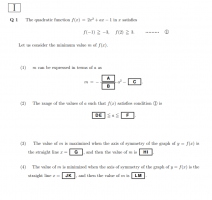satsuimiamo
New member
- Joined
- Sep 9, 2021
- Messages
- 3

from the 2017 EJU. im having trouble with this question in general. i can do 1-2, but im not sure what 3 and 4 are asking. when i use the answers for 2 to plug in for 3 and 4, i dont get the correct answers. when graphed, i can see the maximum and minimum of the function, but i dont know how someone would get there without using a desmos slider. (answers are here, scroll down to the math section. its Q1 for both courses)
